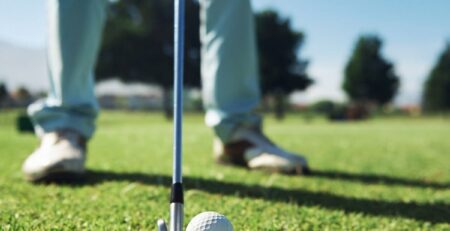Tailoring Exercise Routines for Juniors, Seniors, and Everyone in Between
Golf, often regarded as a leisurely sport, places immense demands on the body. Regardless of age, golf fitness plays a critical role in not just enhancing performance but also preventing injuries.
Developing a fitness routine tailored to your age can help optimise your strength, flexibility, and balance – all vital elements for a powerful and efficient golf swing.
Understanding Age-Related Considerations
Understanding age-related considerations is essential when designing a fitness routine that caters to the specific needs and capabilities of different age groups. As individuals age, their bodies undergo various changes that can impact their physical abilities and overall health. Here are some important age-related considerations to keep in mind:
Muscle Strength and Mass
Muscle strength and mass tend to decline with age, a process known as sarcopenia. To counteract this, it is crucial to incorporate strength training exercises into the fitness routine. Resistance training helps maintain and build muscle strength, which is vital for maintaining mobility, stability, and overall functionality.
Flexibility and Range of Motion
Flexibility tends to decrease with age due to factors such as decreased collagen production and joint stiffness. Regular stretching exercises that target major muscle groups can help improve and maintain flexibility, promoting better joint mobility and reducing the risk of injury.
Balance and Stability
Age-related changes, such as decreased sensory perception and muscle strength, can affect balance and stability. Including exercises that challenge balance, such as balance boards or single-leg exercises, can help improve proprioception and stability. This is particularly important for fall prevention and maintaining independence.
Bone Health
Bone density tends to decrease with age, increasing the risk of osteoporosis and fractures. Weight-bearing exercises, such as walking, jogging, or resistance training, can help improve bone density and maintain skeletal health. Adequate calcium and vitamin D intake should also be considered to support bone health.
Cardiovascular Health
Regular cardiovascular exercise is crucial for maintaining heart health and overall fitness. Age-related considerations may include adjusting the intensity and duration of aerobic activities based on individual fitness levels and any underlying health conditions. Low-impact exercises, such as swimming or cycling, may be more suitable for individuals with joint issues or reduced mobility.
Recovery and Injury Prevention
With age, the body may require more time to recover from physical activity and be more susceptible to injuries. Incorporating proper warm-up and cool-down routines, as well as listening to the body’s signals, is important to prevent overexertion and minimise the risk of injury.
It’s important to consult with healthcare professionals or certified fitness trainers who have expertise in working with different age groups. They can provide personalised guidance and recommendations based on individual needs, goals, and any pre-existing medical conditions.
Fitness Considerations for Juniors
When it comes to junior golfers, the primary focus should be on developing a solid foundation of movement, coordination, and overall fitness. The exercises should aim to build strength, flexibility, and balance, while also promoting proper movement patterns and body awareness. Here are some considerations for junior golfers:
- Bodyweight Exercises: Incorporate bodyweight exercises such as squats, lunges, push-ups, planks, and mountain climbers. These exercises help build overall strength, stability, and body control, which are essential for a strong golf swing.
- Coordination and Agility: Include activities that promote coordination, balance, and agility. Jumping rope, playing catch, ladder drills, and cone exercises are excellent choices to enhance motor skills and body awareness.
- Core Stability: Focus on developing core strength and stability. Exercises like plank variations, Russian twists, and medicine ball rotations can help strengthen the core muscles necessary for an efficient golf swing.
- Flexibility: Encourage regular stretching exercises to improve flexibility. Emphasise stretches for the shoulders, hips, hamstrings, and back to promote a full and unrestricted range of motion in the golf swing.
Fitness Considerations for Adults and Middle-Aged Golfers
For adults and middle-aged golfers, fitness routines should be tailored based on individual fitness levels, goals, and any specific limitations or injuries. Consider the following:
- Core Strength: Place emphasis on exercises that target core strength, such as plank variations, bird dogs, and cable wood chops. A strong core helps stabilise the body and generate power during the golf swing.
- Rotational Power Training: Incorporate exercises that improve rotational power, such as medicine ball throws, cable rotations, and kettlebell swings. These exercises enhance the ability to generate clubhead speed and improve overall swing mechanics.
- Flexibility Workouts: Include regular stretching and flexibility exercises to improve range of motion and prevent injuries. Incorporate yoga or Pilates sessions that focus on flexibility, balance, and body control.
- Cardiovascular Fitness: Engage in aerobic activities such as brisk walking, jogging, or cycling to improve cardiovascular fitness and endurance, which can enhance stamina during rounds of golf.
Fitness Considerations for Seniors
Senior golfers may face common age-related challenges and physical limitations. It is important to prioritise exercises that improve flexibility, joint mobility, balance, and stability. Consider the following:
- Gentle Stretching Routines: Regularly perform gentle stretching exercises to improve flexibility, especially in the shoulders, hips, and lower back. Stretching can help maintain joint mobility and prevent stiffness.
- Tai Chi or Yoga for Balance: Participate in balance-focused activities like Tai Chi or specific yoga routines designed for seniors. These exercises enhance stability, body awareness, and reduce the risk of falls.
- Resistance Band Exercises: Utilise resistance bands to perform exercises that target joint mobility and strengthen muscles without placing excessive stress on the joints. Exercises like band-assisted shoulder rotations and leg raises can be beneficial.
- Low-Impact Aerobics Activities: Engage in low-impact aerobic exercises, such as swimming, water aerobics, or stationary cycling, to maintain cardiovascular health without putting excessive strain on joints.
Golf-Specific Exercises for All Ages
Golf-specific exercises are beneficial for individuals of all ages, as they target the key muscles and movement patterns involved in the golf swing. By incorporating these exercises into a regular fitness routine, golfers can improve their strength, flexibility, stability, and overall performance on the course. Here are some golf-specific exercises suitable for all age groups:
Band-Assisted Torso Rotations
Using a resistance band anchored at chest height, stand with your feet shoulder-width apart and hold the band with both hands. Rotate your torso away from the anchor point, mimicking the rotational movement of the golf swing. This exercise helps strengthen the core muscles and improves the range of motion needed for an efficient swing.
Medicine Ball Slams
Hold a medicine ball with both hands, standing with your feet shoulder-width apart. Raise the ball overhead and forcefully slam it down to the ground, engaging your core and utilising your hips and upper body in the movement. This exercise develops explosive power and mimics the downward motion of the golf swing.
Golf-Specific Yoga Poses
Incorporate yoga poses that target flexibility, balance, and stability. Poses such as the Warrior II pose, Tree pose, and Standing Forward Bend can help improve lower body strength, balance, and flexibility. Additionally, yoga poses like the Twisted Chair pose and Spinal Twist pose enhance rotational mobility and improve core strength for an effective golf swing.
Rotational Cable Exercises
Using a cable machine or resistance band, perform rotational exercises that simulate the golf swing. Stand with your side facing the anchor point, hold the handle with both hands, and rotate your torso away from the anchor point while maintaining stability through the lower body. This exercise strengthens the muscles responsible for rotation and enhances core stability.
Balance and Stability Exercises
Include exercises that challenge balance and stability, such as single-leg stands, heel-to-toe walks, or standing on an unstable surface like a balance board or foam pad. These exercises improve proprioception, stability, and coordination, essential for a controlled and balanced golf swing.
Remember to start with proper form and gradually increase the intensity and difficulty of the exercises over time. It is advisable to consult with a fitness professional or golf-specific trainer to ensure that the exercises are performed correctly and tailored to individual abilities and needs.
Injury Prevention and Recovery Strategies
Injury prevention and recovery strategies are essential for golfers to maintain a healthy and injury-free body.
- Warm-Up Routines: Before engaging in any physical activity, including golf, it is crucial to warm up properly. A warm-up routine should include dynamic stretches and exercises that target the major muscle groups used in the golf swing. Dynamic stretches involve controlled movements that gently stretch the muscles and increase blood flow, preparing them for the upcoming activity. Examples of dynamic stretches for golfers include arm circles, hip rotations, and torso twists.
- Cool-Down Routines: After completing a round of golf or a practice session, it is important to cool down and allow the body to gradually return to a resting state. Cool-down routines typically involve static stretching exercises that help improve flexibility, reduce muscle tension, and promote recovery. Hold each stretch for 15-30 seconds without bouncing or jerking. Focus on stretching the major muscle groups, including the shoulders, back, hips, and legs.
- Injury Management and Recovery: Despite preventive measures, injuries can still occur. If you sustain an injury while playing golf, it is crucial to address it promptly and seek appropriate medical advice. Common strategies for managing and recovering from golf-related injuries include:
- Rest: Allow your body time to heal by avoiding activities that aggravate the injury. Rest is essential for recovery and preventing further damage.
- Ice: Apply ice or a cold pack to the injured area to reduce pain, inflammation, and swelling. Use an ice pack for 15-20 minutes at a time, several times a day.
- Compression: Use compression wraps or bandages to help reduce swelling and provide support to the injured area. Ensure that the compression is firm but not too tight to restrict circulation.
- Elevation: Elevate the injured area above the level of your heart to help reduce swelling. Prop the injured limb on pillows or cushions whenever possible.
- Professional Guidance: Consult with a healthcare professional, such as a physiotherapist or sports medicine specialist, for an accurate diagnosis, personalised treatment plan, and guidance on rehabilitation exercises. They can provide specific exercises and therapies tailored to your injury and help facilitate a safe and efficient recovery.
Incorporating Mental Fitness
While physical fitness is crucial in golf, mental fitness plays an equally important role in achieving peak performance on the course. Here are some expanded details on incorporating mental fitness into your golf routine:
- Focus and Concentration: Enhancing focus and concentration is vital for consistent performance in golf. Mindfulness meditation is a powerful technique that can improve focus by training the mind to be present in the moment. Practicing mindfulness helps golfers stay calm, composed, and fully engaged in each shot, reducing distractions and enhancing performance.
- Visualisation Exercises: Visualisation is a technique used by many successful golfers to mentally rehearse shots before actually hitting them. By vividly imagining the desired ball flight, trajectory, and successful outcomes, golfers can enhance their confidence, improve muscle memory, and reinforce positive mental images. Regularly incorporating visualisation exercises into your practice routine can boost performance and mental readiness on the course.
- Regular Mental Health Check-Ins: Golf can be mentally demanding, and it is important to regularly assess and address your mental well-being. Taking time to reflect on your emotions, stress levels, and overall mental state can help identify areas that require attention and support. Engaging in activities that promote relaxation, such as yoga, meditation, or engaging in hobbies outside of golf, can also contribute to mental well-being and overall balance.
Whether you’re a junior picking up the club for the first time or a senior seasoned in the game, golf fitness is a key factor in enhancing performance and minimising injury. With a tailored fitness routine that accounts for your age and unique needs, you can enjoy the game of golf healthily and effectively at any stage of life.
Mastering the Mental Game: Strategies for Improving Focus and Confidence on the Course
The game of golf is as much a mental endeavour as it is a physical one. While technique and fitness are crucial, mental agility is often the dividing line between good and great players. This article explores the importance of mental resilience, focus, and confidence in enhancing golf performance.
Understanding the Role of the Mind in Golf
Understanding the role of the mind in golf is crucial for achieving peak performance on the course. Golf is not just a physical game; it is also a mental game. Here are some expanded insights into the role of the mind in golf and strategies to handle mental challenges:
Pressure Situations
Golf often presents pressure situations, such as crucial putts or shots with high stakes. The ability to perform under pressure is a vital mental skill. Strategies to handle pressure include deep breathing techniques to calm nerves, positive self-talk to boost confidence, and focusing on the process rather than the outcome. By staying present, maintaining composure, and focusing on the task at hand, golfers can better manage pressure situations.
Focus Amidst Distractions
Maintaining focus amidst distractions is a common challenge in golf. External factors such as noise, crowds, or adverse weather conditions can divert attention. Internal distractions, such as negative thoughts or self-doubt, can also hinder performance. Developing a pre-shot routine helps establish focus and consistency. Techniques like visualisation and mindfulness meditation can improve concentration, allowing golfers to block out distractions and maintain focus on their shots.
Managing Failures
Golf is a game of ups and downs, and managing failures is essential for mental resilience. Understanding that mistakes are part of the game and viewing them as learning opportunities can help golfers bounce back from setbacks. Adopting a growth mindset, where failures are seen as opportunities for improvement, can help maintain a positive attitude and prevent negative emotions from affecting future performance.
Goal Setting and Positive Self-Talk
Setting specific and achievable goals is essential for maintaining motivation and focus. Goals can be both performance-based (e.g., improving accuracy) and process-based (e.g., sticking to a consistent routine). Positive self-talk, using affirmations and constructive language, helps build confidence, manage self-doubt, and maintain a positive mindset throughout the round.
Visualisation and Mental Imagery
Visualisation is a powerful mental technique used by golfers to imagine successful shots and outcomes. By visualising the desired ball flight, landing spot, and successful execution, golfers can enhance confidence, build muscle memory, and reinforce positive mental images. Practicing mental imagery during both practice sessions and on the course can positively impact performance.
Emotional Regulation and Stress Management
Emotional regulation is crucial for maintaining composure and making sound decisions on the golf course. Developing strategies to manage stress, such as deep breathing exercises, progressive muscle relaxation, and positive coping mechanisms, can help golfers stay calm and focused in challenging situations.
Developing a Pre-Shot Routine
Establishing a consistent pre-shot routine is a fundamental aspect of a golfer’s mental strategy. A pre-shot routine serves multiple purposes, including creating a sense of familiarity, building confidence, setting the tempo for the shot, and focusing the mind on the task at hand. Here is an expanded explanation of the importance of a consistent pre-shot routine and its key elements:
- Familiarity and Confidence: A consistent pre-shot routine establishes a familiar sequence of actions and rituals that golfers can rely on. By performing the same routine before each shot, golfers develop a sense of comfort and confidence. The repetition of the routine reinforces positive muscle memory and mental associations, leading to increased trust in their abilities.
- Tempo and Timing: A pre-shot routine helps set the tempo and rhythm for the shot. By going through a consistent sequence of actions, golfers establish a natural cadence that promotes a smooth and controlled swing. This consistent tempo allows golfers to maintain composure and execute shots with proper timing, minimising rushed or erratic swings.
- Mental Focus and Visualisation: The pre-shot routine provides an opportunity to focus the mind and visualise the desired shot. By incorporating mental imagery during the routine, golfers can create a clear mental picture of the intended ball flight, trajectory, and target. This visualisation primes the mind for success and enhances confidence in executing the shot.
- Systematic Setup: A consistent pre-shot routine helps golfers approach the setup of each shot in a systematic manner. This includes selecting the target, aligning the body and clubface, and taking a practice swing or two. A systematic setup ensures that all aspects of the shot are considered and addressed consistently, minimising errors or oversights that could impact the outcome.
Consistency is the key element in a pre-shot routine. By repeating the same actions and rituals before each shot, golfers establish a reliable process that becomes ingrained in their routine. Consistency breeds familiarity, confidence, and a sense of control, which can positively influence performance.
It’s important to note that a pre-shot routine can be personalised to suit an individual golfer’s preferences and style. While the specific actions and sequence may vary, the underlying principle of consistency remains the same. Experimenting with different elements and observing their impact on focus and performance can help golfers refine and personalise their pre-shot routine.
Building Mental Resilience
Building mental resilience is a crucial aspect of golf. The ability to bounce back from setbacks, maintain a positive attitude, and stay focused is essential for consistent performance on the course. Here are expanded details on building mental resilience and enhancing focus and concentration in golf:
Reframing Negatives into Positives:
Developing the ability to reframe negative situations or outcomes into positive learning experiences is key to building mental resilience. Rather than dwelling on mistakes or setbacks, view them as opportunities for growth and improvement. Emphasise the lessons learned and the potential for future success.
Setting Realistic Expectations:
Maintaining realistic expectations is essential for mental resilience. While it’s important to set goals and strive for improvement, it’s equally important to acknowledge that golf is a challenging and unpredictable game. Setting achievable goals and understanding that progress may come gradually helps prevent unnecessary frustration and disappointment.
Maintaining a Growth Mindset:
Adopting a growth mindset is crucial for developing mental resilience. Embrace the belief that abilities and skills can be developed through dedication, effort, and a willingness to learn. Approach challenges as opportunities to develop and expand your capabilities, rather than as fixed limitations.
Enhancing Focus and Concentration
Redirecting your focus from potential hazards to the target can help maintain a positive and confident mindset. By visualising the desired outcome and directing your attention to the intended target, you can shift your focus away from potential obstacles or negative thoughts, enabling you to execute with clarity and purpose.
Using Breath as a Focal Point:
Using your breath as a focal point is a powerful technique to enhance focus and concentration. Take slow, deep breaths, paying attention to the sensation of your breath entering and leaving your body. Focusing on your breath helps anchor your attention in the present moment, reducing distractions and promoting a calm and cantered state of mind.
Practicing Mindfulness and Meditation:
Incorporating mindfulness and meditation into your routine can improve focus, concentration, and mental resilience. Mindfulness involves being fully present in the moment, observing thoughts and sensations without judgment. Meditation exercises, such as body scans or guided meditations, help train the mind to maintain focus and regulate emotions, enabling you to stay in the present and perform at your best.
Building Confidence On and Off the Course
Self-confidence, both on and off the course, greatly influences performance. Bolster confidence by reflecting on past successes, setting and achieving small goals, and using positive self-talk and affirmations. A confident golfer trusts their abilities and is more likely to perform well under pressure.
Managing Pressure Situations
Golf can present high-pressure situations, especially in competitive play. Strategies for managing pressure include:
Deep Breathing Exercises:
In high-pressure situations, deep breathing exercises can help calm your nerves and reduce anxiety. Take slow, deep breaths, inhaling through your nose and exhaling through your mouth. This technique helps activate the body’s relaxation response and promotes a sense of calmness.
Focus on the Process:
Shift your focus from the outcome to the process of executing each shot. By concentrating on the steps involved in setting up, visualising, and executing the shot, you can stay in the present moment and maintain focus. This approach helps alleviate the pressure associated with the outcome and allows you to perform to the best of your abilities.
Embrace Pressure as a Challenge:
Rather than viewing pressure as a threat, reframe it as an exciting challenge. Recognise that pressure situations provide an opportunity to showcase your skills and rise to the occasion. Embracing pressure with a positive mindset can help you perform at your best under demanding circumstances.
Overcoming Negative Thinking and Self-Doubt
Recognise Negative Thought Patterns: Be aware of negative thoughts or self-doubt that may arise during rounds of golf. Recognising these patterns is the first step towards overcoming them. Acknowledge their presence, but don’t allow them to dominate your mindset.
Challenge and Replace Negative Thoughts:
Challenge negative thoughts by questioning their validity. Replace them with positive and realistic statements. For example, if you miss a shot, instead of thinking “I’m terrible at this,” replace it with “I can learn from this and improve.”
Utilising Mental Imagery and Visualisation
Utilise mental imagery to visualise successful shots and positive outcomes. Close your eyes and imagine the desired ball flight, the feeling of a well-executed swing, or sinking important putts. Visualising success helps create a mental blueprint for your body to follow during actual execution.
Incorporate visualisation techniques during practice sessions. Before each shot, mentally rehearse the desired outcome, focusing on the details of the swing, trajectory, and landing spot. This practice helps improve focus, confidence, and muscle memory, leading to more effective performance on the course.
Seeking Professional Guidance and Support
Consistent practice and application of mental strategies are key to mastering the mental game. However, don’t hesitate to seek professional guidance. Mental game coaches or sports psychologists can provide personalised strategies and support.
In golf, mastering the mental game is just as crucial as perfecting your swing. Understanding the mind’s role, developing routines, building resilience, enhancing focus, fostering confidence, managing pressure, overcoming negativity, and harnessing visualisation are all integral to improving performance.











